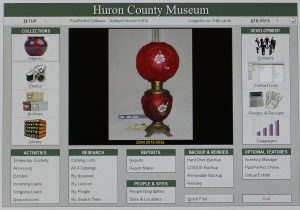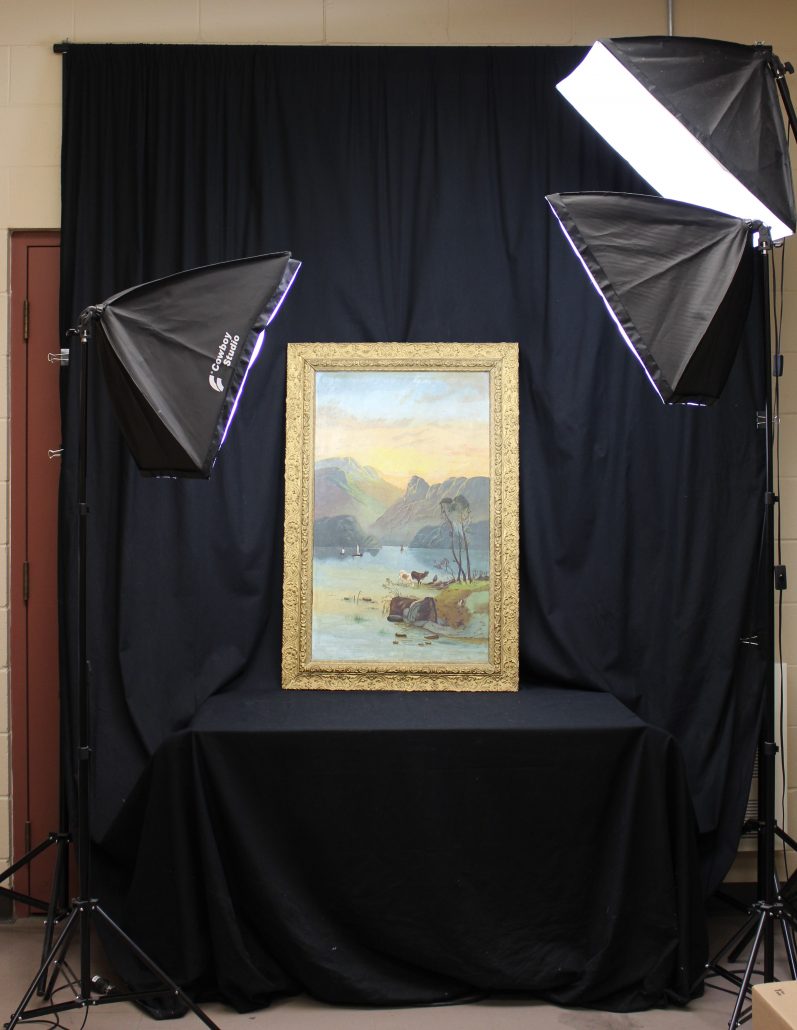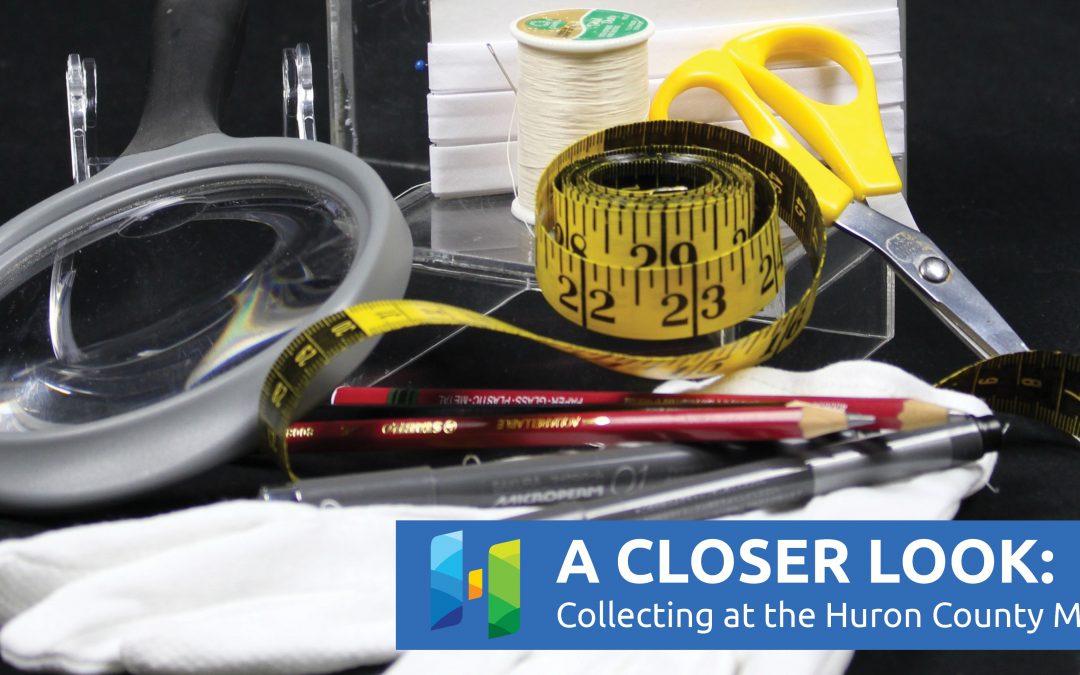Take a closer look at the Huron County Museum & Historic Gaol and its collections as staff share stories about some well-known and some not-so-well-known features, artifacts, and more. In the second of a three-part series, Registrar Patti Lamb takes a closer look at the Museum’s collections and the process of accepting and cataloguing donations into the collection. Read Part 1 on Museum’s Secret Codes and Part 3 on Deaccessioning Artifacts.
Visitors and members of the general public are often curious as to what happens behind the scenes at the Huron County Museum. Questions commonly asked to the staff are: what happens to the “stuff” once it’s donated; what does the collections staff do; where does the museum put all the “stuff”; and what happens when the museum is done with it? These are all really good questions and this blog is an attempt to share the different roles of the Collections staff and what happens when someone has donated something to the Museum.

Museum Technician Heid Zoethout, Registrar Patti Lamb, and Archivist Michael Molnar are three of the primary roles within the Museum’s Collections staff.
A Collections Team
There are three primary roles within the Collections staff. They are the Archivist, Museum Technician, and Registrar. Each role works separately within their own individual job descriptions but they all work together as a team.
The Archivist is responsible for the archival collection which includes all paper based, 2 dimensional items such as photographs, documents, diaries, and minute books. The Archivist processes donor forms; documents and catalogues the donations of archival material; and conducts research for or assists with research for others.

PastPerfect is the Museum’s Collections Management System
The Museum Technician is responsible for the housing and location of the artifacts. The Technician makes sure the artifacts are stored properly; are safely handled and displayed in ways that are not damaging; and locates the artifacts in the museum buildings and the collections database. This role also monitors temperature, humidity, and light levels.
The Registrar looks after the documentation of donations of three-dimensional objects; processes donor forms; catalogues the artifacts to include detailed descriptions and provenance; photographs the artifacts; and maintains PastPerfect, the Museum’s Collection Management Software. This role also looks after the documentation of incoming and outgoing loans as well as conducts research on objects in the Collection.
How to Donate to the Collection
When someone is interested in making a donation to the Huron County Museum, they need to contact the Archivist for archival material, or the Registrar for three-dimensional objects. This blog is going to focus on three-dimensional object donations, but the process is basically the same for archival material. Anything being considered for donation to the Museum must meet the collections mandate or criteria. Items must have historical relevance to Huron County, meaning they must have been used or manufactured in Huron County, or have a significant provenance (history) that ties them to the County. Artifacts should also be in good condition.
Once contacted to inquire about donating items, the Registrar will chat, either by phone or email, with the potential donor to determine the relevance of the items. Usually the donor will be asked to email some photographs of the object(s) so the condition can be determined and to make clear what the object is they wish to donate. Most times the donor will not be given an acceptance or denial answer right away. The Registrar wants to look at the potential donation, and take some time to do a search in the database to see if there are duplicate items such as the ones that are being offered. If the Museum does have several similar items, it needs to be determined if the ones in the Collection have a detailed story or history associated with them or if the new item would tell a better story.
Once it has been determined that the artifact will be accepted into the Collection, an appointment is made between the Registrar and the donor to bring the item to the Museum. At that appointment, gift forms (donor forms) are prepared by the Registrar for both the donor and Registrar to sign. Included on the form is the donor’s name, address, and contact information; item(s); and a detailed history (provenance) about the item. Information also includes where, when, and how it was used; by whom it was used; and how the donor came to have it.
By signing the donor form, the donor is stating that they have the legal right to the item and can therefore sign ownership over to the Museum. Once the form is signed, the artifact becomes the legal property of the Museum. If the donor wants an income tax receipt for their donation a further step will be taken. Prior to the appointment, the donor must obtain a written appraisal of the artifact. The appraisal must be on the letterhead of the appraiser or antiques dealer and accompany the donor to the appointment. The appraisal is given to the Registrar with the artifact and once the gift forms are signed, an income tax receipt will later be prepared and mailed to the donor.

Photographing an artifact is the last step in the cataloguing process.
Cataloguing the Donation
When the paperwork is complete, the cataloguing process can begin. Cataloguing an artifact includes assigning an object ID number and documenting as much information as possible about the object. A detailed description is required describing all the physical attributes of the item such as measurements, colour, material makeup, condition, and functionality. The record will also include how, where, and when the object was used. Often research is involved to discover important facts regarding the object, the family that used it, or the business from where it came. The history of an object is just as important as the object itself. For example, a quilt is just a quilt, but a quilt with a good description and detail about why it was made, who made it, who used it, and where it was used makes it much more interesting and relatable.
An object ID number is then added to the object in a way that does not damage the artifact. Textiles will have a cloth label sewn onto them and objects with harder surfaces have a number added that is removable should it need to be.
The last step in the cataloguing process is photography. Each object is photographed in detail showing all sides, close ups of significant or interesting parts, and any condition issues such as cracks or peeling paint. Photographs are then added to the record in the database and ultimately uploaded with the record to the Online Collection, which features over 6,000 artifacts from the Museum’s collection.
When the object is completely catalogued, it is placed in a temporary location in the main storage area for the Museum Technician to then find it a permanent home. The permanent location is documented in the database so the artifact is accessible to go on exhibit or loan, or be used in research when needed.

